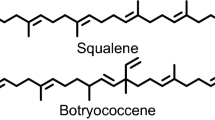Abstract
Adjuvants are typically used in subunit vaccine formulations to enhance immune responses elicited by individual antigens. Physical chemical characterization of novel adjuvants is an important step in ensuring their effective use in vaccine formulations. This paper reports application of a panel of quantitative assays developed to analyze and characterize an oil-in-water adjuvant emulsion, which contains glucopyranosyl lipid A (GLA) and is a squalene-based emulsion. GLA is a fully synthetic analogue of monophosphoryl lipid A, which is a Toll-like receptor type 4 agonist and an FDA-approved adjuvant. The GLA-stable emulsion (GLA-SE) is currently being used for a respiratory syncytial virus vaccine in a phase 2 clinical trial. GLA was quantitated using reverse-phased high-performance liquid chromatography (RP-HPLC) coupled to a mass spectrometric detector, achieving higher assay sensitivity than the charged aerosol detection routinely used. Quantitation of the excipients of GLA-SE, including squalene, egg phosphatidyl choline, and Poloxamer 188, was achieved using a simple and rapid RP-HPLC method with evaporative light scattering detection, eliminating chemical derivatization typically required for these chromophore-lacking compounds. DL-α-tocopherol, the antioxidant of the GLA-SE, was quantitated using a RP-HPLC method with conventional UV detection. The experimental results compared well with values expected for these compounds based on targeted composition of the adjuvant. The assays were applied to identify degradation of individual components in a GLA-SE sample that degraded into distinct aqueous and oil phases. The methods developed and reported here are effective tools in monitoring physicochemical integrity of the adjuvant, as well as in formulation studies.









Similar content being viewed by others
References
Bomford R. Will adjuvants be needed for vaccines of the future? Dev Biol Stand. 1998;92:13–7.
Coler RN et al. A synthetic adjuvant to enhance and expand immune responses to influenza vaccines. PLoS ONE. 2010;5(10):e13677.
Baldwin SL, Bertholet S, Reese VA, Ching LK, Reed SG, Coler RN. The importance of adjuvant formulation in the development of a TB vaccine. J Immunol. 2012;188(5):2189–97.
Reed SG, Orr MT, Fox CB. Key roles of adjuvants in modern vaccines. Nat Med. 2013;19:1597–608.
Vogel FR, Caillet C, Kusters IC, Haensler J. Emulsion-based adjuvants for influenza vaccines. Expert Rev Vaccines. 2009;8(4):483–92.
Baldwin SL, Shaverdian N, Goto Y, Duthie MS, Raman VS, et al. Enhanced humoral and type 1 cellular immune responses with fluzone adjuvanted with a synthetic TLR4 agonist formulated in an emulsion. Vaccine. 2009;27(43):5956–63.
Coler RN, Bertholet S, Moutaftsi M, Guderian JA, Windish HP, et al. Development and characterization of synthetic glucopyranosyl lipid a adjuvant system as a vaccine adjuvant. PLoS ONE. 2011;6(1):e16333.
Baldridge JR, Crane RT. Monophosphoryl lipid a (MPL) formulations for the next generation of vaccines. Methods. 1999;19:103–7.
Cunningham AL. The herpes zoster subunit vaccine (shingrix). Expert Opin Biol Ther. 2015;1471–2598.
Anderson RC, Fox CB, Dutill TS, Shaverdian N, Evers TL, et al. Physicochemical characterization and biological activity of synthetic TLR4 agonist formulations. Colloids Surf B Biointerfaces. 2010;75(1):123–32.
Lambert SL et al. A novel respiratory syncytial virus F subunit vaccine adjuvanted with GLA-SE elicits robust protective Th1-type humoral and cellular immunity in rodent models. PLoS ONE. 2015;10(3):e0119509.
A study to evaluate the safety of respiratory syncytial virus vaccine MEDI7510 in older adults. https://clinicaltrials.gov/ct2/show/NCT02115815.
Fox CB. Characterization of TLR4 agonist effects on alhydrogel® sedimentation: a novel application of laser scattering optical profiling. J Pharm Sci. 2012;101:4357–64.
Walton WH. Feret’s statistical diameter as measure of particle size. Nature. 1948;162:329–30.
Misquith A, Millie Fung HW. In vitro evaluation of TLR4 agonist activity: formulation effects. Colloids Surf B: Biointerfaces. 2014;113:312–9.
The AOCS Lipid Library. HTML: http://lipidlibrary.aocs.org
Chung HH, Zhou CF, Khor HK, Qiu J. Direct determination of residual pluronic F-68 in in-process samples from monoclonal antibody preparation by high performance liquid chromatography. J Chromatogr A. 2011;1218(15):2106–13.
Fox CB, Baldwin SL, Duthie MS, Reed SG, Vedvick TS. Immuno-modulatory and physical effects of phospholipid composition in vaccine adjuvant emulsions. AAPS PharmSciTec. 2012;13(2):498–506.
Acknowledgments
The authors like to thank the NanoImaging Services (San Diego, CA) for providing the cryo-EM data.
Author information
Authors and Affiliations
Corresponding author
Ethics declarations
Conflict of Interest
The authors declare that they have no conflict of interest.
Electronic Supplementary Material
Below is the link to the electronic supplementary material.
Esm 1
(DOCX 875 kb)
Rights and permissions
About this article
Cite this article
Sun, J., Remmele, R.L. & Sanyal, G. Analytical Characterization of an Oil-in-Water Adjuvant Emulsion. AAPS PharmSciTech 18, 1595–1604 (2017). https://doi.org/10.1208/s12249-016-0626-8
Received:
Accepted:
Published:
Issue Date:
DOI: https://doi.org/10.1208/s12249-016-0626-8



